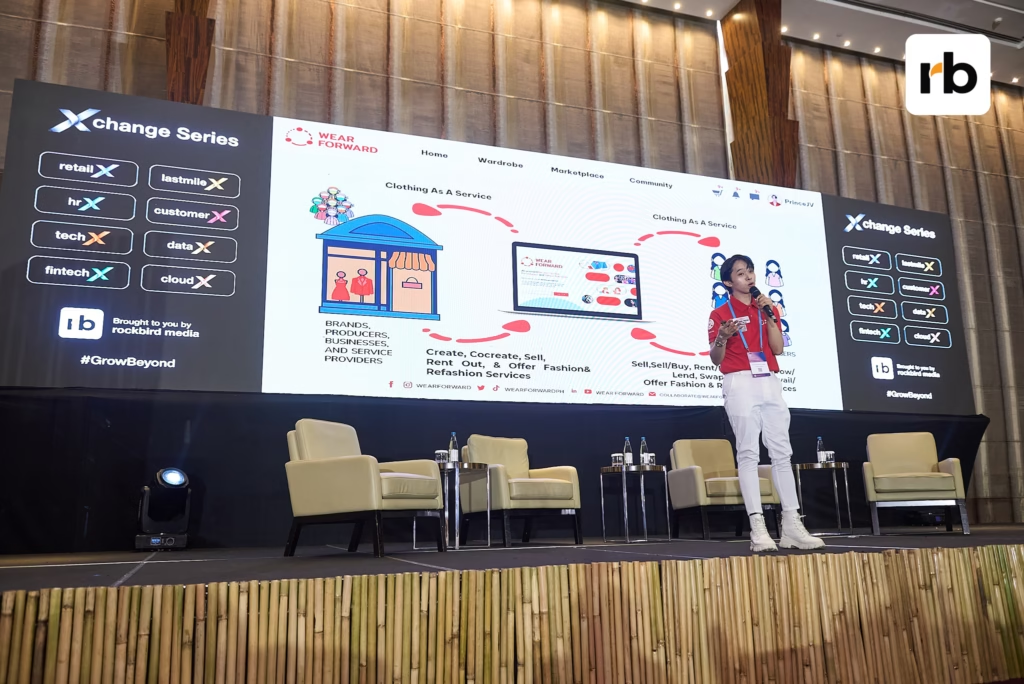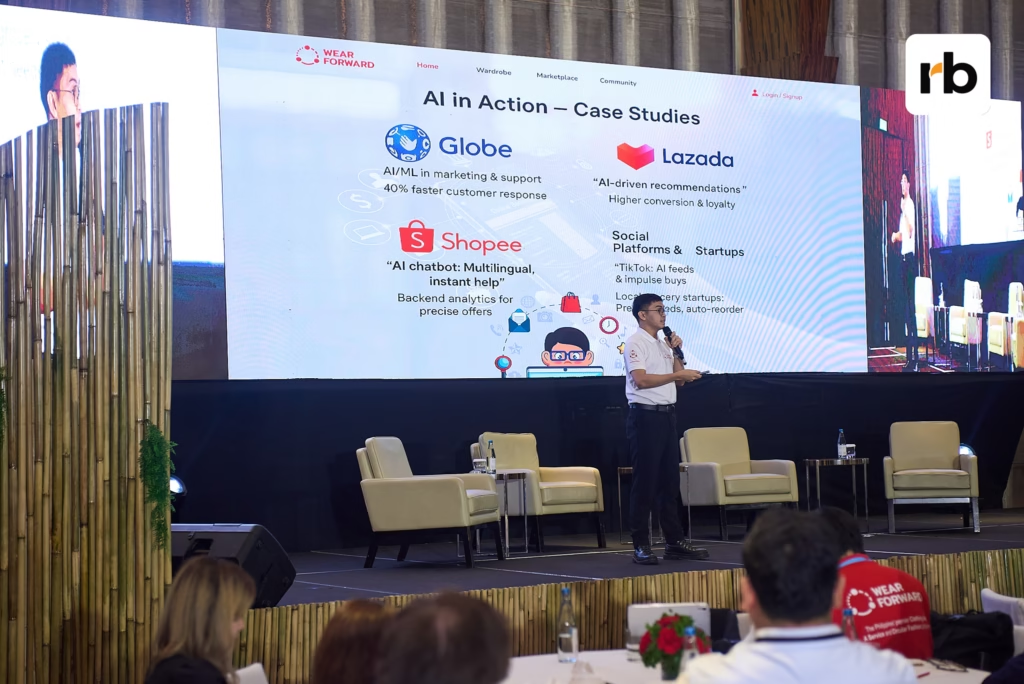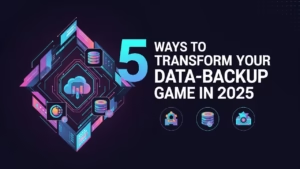In a sea of trends that come and go, one message stood out at RESA 2025: fashion doesn’t need to be fast to be forward. And leading that conversation was Prince JImdel Ventura, Founder and CEO of Wear Forward, a tech-driven circular fashion startup reshaping how Filipinos interact with clothing, consumption and community.
Against the backdrop of soaring digital retail and increasing environmental consciousness, Prince’s session, AI-Driven Consumer Insights: Understanding the Filipino Shopper, tackled two pressing needs: intelligent retail and sustainable fashion.
Wear Forward: A Circular Alternative to Disposable Fashion
At the core of Prince’s talk was Wear Forward’s Clothing-as-a-Service (CaaS) model—an ecosystem that allows users to buy, rent, sell, swap, repair, donate or even access free fashion services.
“We don’t need more trends,” Prince said. “We need to bring back life back to the classics and reduce fashion waste.”
With over 60% of clothing going unused after just one or two wears, especially in fast-paced urban lifestyles, Prince emphasized the power of a shared wardrobe economy. His model not only aims to minimize waste and textile pollution—but also to build inclusivity by giving people affordable, stylish and sustainable access to clothing.
He stressed that circularity isn’t just ethical—it’s strategic.
The Filipino Shopper: AI and E-Commerce in Action
In today’s hyper-connected landscape, Filipino consumers are more digitally empowered than ever. Following Prince’s discussion, Daniel Caparro, Chief Technology Officer of Wear Forward took the stage to dive deeper into the tech and behavioral data behind the shift.
“There is a massive revenue potential in Philippine retail,” Daniel said.
“But more than that, there’s a transformation in how people decide to spend—and AI is driving that change.”
As of 2024, 78% of the Philippine population is actively purchasing online, driven by growing mobile penetration and accessible digital tools. Platforms like Shopee, Lazada and TikTok Shop aren’t just apps anymore—they’ve become habitual marketplaces integrated into daily life.
Filipinos are spending an average of 3 hours and 34 minutes daily on social media (DataReportal 2024), with platforms like TikTok experiencing the fastest e-commerce growth, especially in categories like beauty, food and most—of all—fashion.
Caparro explained how AI-driven predictive analysis is reshaping the buyer journey.
“You add something to your cart and leave. A few days later, it’s still there—along with bundles, suggestions, flash sales,” he explained.
“That’s not random. That’s AI at work, reading your patterns and refining your experience.”
These recommendation systems don’t just enhance UX—they drive revenue, retention and relevance.
According to GlobalData, the Philippine e-commerce market reached $24.1 billion in 2024, with a YoY growth of 19.6%, and is projected to hit $39.5 billion by 2028. That’s a CAGR of 28.6 %, ranking the Philippines among Southeast Asia’s fastest–growing digital markets.
Caparro emphasized that the future of retail is already happening—and it’s data driven, mobile-first and deeply personal.
AI in Action: Case Studies from the Philippine Market
To illustrate how this plays out in practice, Prince presented several AI success stories—evidence that AI is not a far-off vision, but already deeply embedded in customer service, product recommendations and supply chain forecasting:
Globe Telecom: By integrating AI/ML into its customer support channels, Globe improvised response times by up to 40%, significantly enhancing user satisfaction in a traditionally delayed service area.
Lazada: Their AI-powered personalized recommendations boosted both conversion rates and customer loyalty, allowing users to discover relevant items based on past browsing and purchasing patterns.
Shopee: with a rapidly growing base of multilingual users, Shopee developed instant-response AI chatbots that operate in Tagalog, English and other local dialects. These bots now handle everything from product inquiries to refund assistance.
Startups and Social Platforms: From AI feeds on TikTok to auto-reordering algorithms used by local grocery startups, smaller players are using machine learning to predict needs, automate inventory stocks and provide better on-demand service.
Prince summed it up best:
“You might not see it, but AI is behind almost every scroll, suggestion and swipe.”
Whether it’s through chatbots personalized feeds or inventory prediction, the message was clear: AI is no longer optional—it’s already powering the everyday digital experience of Filipino shoppers.
Challenges and Opportunities in Philippine Retail
While the growth is promising, Prince didn’t shy away from highlighting the critical bottlenecks facing Philippine digital commerce:
Challenges:
- Infrastructure Gaps: With only 22,000+ existing cell towers, the country falls short of the 70,000+ needed to ensure stable internet across rural areas.
- Cash Culture: around 30% of the population remains unbanked (BSP 2024), relying on cash transactions—making digital adoption slower outside urban hubs.
- Data Privacy and Trust: Filipinos are increasingly concerned about how their data is being used. Without stronger protections, AI-based personalization could spark backlash.
- Regulatory Scrutiny: In 2024 alone, the Department of Trade and Industry (DTI) logged over 36,000 e-commerce complaints, many linked to fraud, delivery failures or misleading ads.
But Prince emphasized that challenges breed innovation and the Philippines is standing on the edge of a digital renaissance.
Opportunities:
- Mobile-First Adoption: With over 117 million mobile connections, the country is primed for mobile-first AI applications, including livestream selling, social commerce and in-app payment solutions.
- Cloud Expansion: Giants like AWS, Azure and Google Cloud are investing in local data centers, lowering costs and improving access to advanced tools for MSMEs.
- MSME Digitalization Support: Government initiatives such as Go Digital Pilipinas and the DIT’s MSME mentoring programs are accelerating tech readiness among small local brands.
- Social Commerce Potential: Filipinos are naturally community-driven and highly engaged on social platforms. Combining AI-targeted ads with influence-driven livestreams opens up a vast frontier for both sales and social impact.
Advice for Aspiring Entrepreneurs
When asked what advice he’d give to those hoping to launch a startup or enter the fashion-tech space, Prince gave a heartfelt and practical response:
“Fall in love with the problem, not the solution. Most people build something they think is cool—but don’t validate if the market needs it.”
He emphasized that defining the pain point is where the real innovation starts.
“Be ready to sacrifice your time, comfort and even money. Fail fast, learn and relaunch. The clarity comes when you commit to solving the problem completely.”
As a Clothing Technology graduate from UP, Prince’s advice blended both idealism and practicality—exactly what aspiring founders need in a rapidly shifting market.
Actionable Takeaways for Brands and Consumers
For brands, Prince urged:
- Invest in AI-driven analytics
- Integrate offline and online touchpoints (omnichannel selling)
- Be transparent with data
- Collaborate on infra gaps with government and MSMEs
For consumers, the reminder was simple:
- Use digital tools (price comparisons, e-wallets)
- Support transparent brands
- Shop smartly across channels
- Give feedback to improve AI services
Final Thoughts
Wear Forward isn’t just a fashion tech brand—it’s a movement. One that uses AI not just to sell smarter, but to shop better. It challenges both businesses and consumers to redefine value—from what’s new to what’s needed.
At RESA 2025 PH, Prince and Daniel reminded us that:
Innovation isn’t just found in new products or new platforms—sometimes, it’s in new perspectives. In choosing timeless over trendy.

















